

 |
 |

Turtle Island - Romantic Ecotourism Hot Spot of the South Pacific by Kaya Morgan
 Imagine a place where you can lounge on your own private beach while playing in the aquamarine waters and picnicking on the freshest sea delicacies of crab, prawns and lobster. A place of pure hedonism, Turtle Island was given its name by Captain Cook while his crew feasted on sea turtles found abundantly in the surrounding waters. As one of the most exclusive and beautiful places in the South Pacific, this pristine spot has often been referred to, "As close to heaven on earth as you're likely to get."
Imagine a place where you can lounge on your own private beach while playing in the aquamarine waters and picnicking on the freshest sea delicacies of crab, prawns and lobster. A place of pure hedonism, Turtle Island was given its name by Captain Cook while his crew feasted on sea turtles found abundantly in the surrounding waters. As one of the most exclusive and beautiful places in the South Pacific, this pristine spot has often been referred to, "As close to heaven on earth as you're likely to get."
 Now privately owned, Turtle Island was first purchased in 1972 by American millionaire Richard Evanson, a Harvard graduate from Oregon who made his fortune in the U.S. cable television industry. Despite his raging business successes, personal disappointments left Evanson feeling unhappy and spiritually lost. In his quest to reclaim a meaningful life, Evanson was headed to Australia when during a chance stop in Fiji, he heard of an island that was for sale. Little did he know that island would soon become his life's best work.
Now privately owned, Turtle Island was first purchased in 1972 by American millionaire Richard Evanson, a Harvard graduate from Oregon who made his fortune in the U.S. cable television industry. Despite his raging business successes, personal disappointments left Evanson feeling unhappy and spiritually lost. In his quest to reclaim a meaningful life, Evanson was headed to Australia when during a chance stop in Fiji, he heard of an island that was for sale. Little did he know that island would soon become his life's best work.
A bit like Robinson Crusoe expecting to find paradise, instead he gazed upon an island though once richly covered in tropical rainforest, now eroded by rains and tide, ravaged by the fury of tropical cyclones and laid waste by the goats of European settlers. It was as much of a miracle for the island to find Evanson as the island was to become his own salvation.
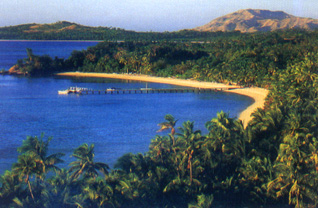 Equipped with little more than a tent, a storage shed and a generator, Evanson set out with the help of a young Fijian, Joe Naisali, to clear a piece of jungle and begin building his new tropical home in paradise. Less than a week later, salvation took on a different meaning when tropical storm, Cyclone Bebe, hit the island with a savage force then unimaginable to Evanson. The two men lashed themselves to the tangled roots of a giant rain tree and prayed for deliverance. Both survived the tortuous night but the damage to the island had been devastating. Amazingly enough, the only tree left standing was the one they were tied to. From that day forward, Richard Evanson was on a mission.
Equipped with little more than a tent, a storage shed and a generator, Evanson set out with the help of a young Fijian, Joe Naisali, to clear a piece of jungle and begin building his new tropical home in paradise. Less than a week later, salvation took on a different meaning when tropical storm, Cyclone Bebe, hit the island with a savage force then unimaginable to Evanson. The two men lashed themselves to the tangled roots of a giant rain tree and prayed for deliverance. Both survived the tortuous night but the damage to the island had been devastating. Amazingly enough, the only tree left standing was the one they were tied to. From that day forward, Richard Evanson was on a mission.
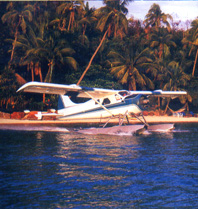 The arduous task of completely reclaiming the island, along with a revamped personal philosophy, transformed Evanson from a self-confessed "overweight indulger into a trim, energetic marathoner." Preserving the natural beauty of his 500-acre, blissful and idyllic island became his single-minded quest. And he has done a most magnificent job. Over the next two decades, Evanson planted over 300,000 tropical saplings to help stop the erosion that was also killing the coral reefs due to the sediment continually drizzling into the sea.
The arduous task of completely reclaiming the island, along with a revamped personal philosophy, transformed Evanson from a self-confessed "overweight indulger into a trim, energetic marathoner." Preserving the natural beauty of his 500-acre, blissful and idyllic island became his single-minded quest. And he has done a most magnificent job. Over the next two decades, Evanson planted over 300,000 tropical saplings to help stop the erosion that was also killing the coral reefs due to the sediment continually drizzling into the sea.
 Although many species did not survive, sturdy Honduras mahogany and orchards of fruit trees grew robustly to supplement the island's own exotic varieties of casurina, lucean, rain trees, shrubs, and flowers. Evanson has carefully swept from the underbrush a single road that circles the island and accesses the freshwater reservoir in the highlands. The island generates its own electricity and all water is recycled so that no waste is released into the ocean. And to protect the natural development of Turtle Island, a 500-year trust has been established that will maintain Richard's dream far beyond his own lifetime.
Although many species did not survive, sturdy Honduras mahogany and orchards of fruit trees grew robustly to supplement the island's own exotic varieties of casurina, lucean, rain trees, shrubs, and flowers. Evanson has carefully swept from the underbrush a single road that circles the island and accesses the freshwater reservoir in the highlands. The island generates its own electricity and all water is recycled so that no waste is released into the ocean. And to protect the natural development of Turtle Island, a 500-year trust has been established that will maintain Richard's dream far beyond his own lifetime.
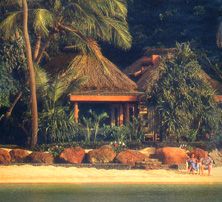 Eventually, Evanson decided that an enchanting paradise such as this must be shared with a few select guests. So, he hand-built fourteen grand bures, cottages with grass-thatched roofs, along the edge of the fabled Blue Lagoon with an equal number of private beaches to savor. Like many of its volcanic neighbor islands, Turtle Island is nature at its most magnificent. "There are no luxury high-rise hotels, tennis courts, or televisions either on Turtle," says Evanson, whose guests arrive by seaplane from Nandi. "Just unspoiled natural beauty and the ancient rhythm of the tides," he adds.
Eventually, Evanson decided that an enchanting paradise such as this must be shared with a few select guests. So, he hand-built fourteen grand bures, cottages with grass-thatched roofs, along the edge of the fabled Blue Lagoon with an equal number of private beaches to savor. Like many of its volcanic neighbor islands, Turtle Island is nature at its most magnificent. "There are no luxury high-rise hotels, tennis courts, or televisions either on Turtle," says Evanson, whose guests arrive by seaplane from Nandi. "Just unspoiled natural beauty and the ancient rhythm of the tides," he adds.
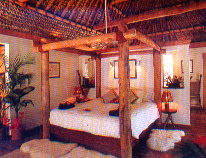 Luxury is the theme of this enchanted island escape. Each grand bure is a spacious suite with cool tile flooring and high vaulted ceilings constructed in the traditional Fijian manner, with hand-shaped and lashed poles of native nokonoko. The roofs of the structures are covered with thick thatching on the outside, with a layer of hand-woven coconut leaves intricately plaited on the ceiling inside. In addition to a bedroom with a four-poster, king-size bed and spacious bath, there is a cozy sitting room with comfortable rattan furniture as well as a fully-stocked refrigerator. If not for all the beauty of the famed Blue Lagoon as you step outside your door, visitors might never leave these cozy, romantic cottages.
Luxury is the theme of this enchanted island escape. Each grand bure is a spacious suite with cool tile flooring and high vaulted ceilings constructed in the traditional Fijian manner, with hand-shaped and lashed poles of native nokonoko. The roofs of the structures are covered with thick thatching on the outside, with a layer of hand-woven coconut leaves intricately plaited on the ceiling inside. In addition to a bedroom with a four-poster, king-size bed and spacious bath, there is a cozy sitting room with comfortable rattan furniture as well as a fully-stocked refrigerator. If not for all the beauty of the famed Blue Lagoon as you step outside your door, visitors might never leave these cozy, romantic cottages.
 Many island guests love to gather around Evenson's long, monkey-pod table and take advantage of the excellent opportunity to make new friends while enjoying a variety of open-air dining and entertaining venues. As part of his commitment to preserving the natural resources, Evanson has created an ingenious way of saving the island's namesake. Once vigorously hunted for their meat and shells, captured sea turtles are now purchased from local fisherman. They are then sold at auction to guests, and the winning bidder has their name carved into the shell. This is harmless to the turtle but renders the shell worthless. The turtle is then freed to roam the wide Pacific once again, and the money goes into the staff Christmas fund.
Many island guests love to gather around Evenson's long, monkey-pod table and take advantage of the excellent opportunity to make new friends while enjoying a variety of open-air dining and entertaining venues. As part of his commitment to preserving the natural resources, Evanson has created an ingenious way of saving the island's namesake. Once vigorously hunted for their meat and shells, captured sea turtles are now purchased from local fisherman. They are then sold at auction to guests, and the winning bidder has their name carved into the shell. This is harmless to the turtle but renders the shell worthless. The turtle is then freed to roam the wide Pacific once again, and the money goes into the staff Christmas fund.
 Dining is exciting and inventive on Turtle Island. With plenty of variety, whether you are in the mood for freshly-caught crab or lobster, prime Australian beef, succulent roasted chicken, grilled local tuna, reef trout, or grouper, fresh garden vegetables grown on the island and many tropical fruits. The friendly Turtle Island staff expertly prepare culinary delicacies such as fresh grilled lobster, Queensland mud crabs, local fish, and succulent fruits from the island's orchards — all accompanied by a bounty of outstanding French, Californian, and Australian wines and champagnes. Everything imaginable, from a seaside moonlight dinner, a mountaintop cocktail party, or an intimate dinner by lantern light on a private beach can be scheduled at a guest's request.
Dining is exciting and inventive on Turtle Island. With plenty of variety, whether you are in the mood for freshly-caught crab or lobster, prime Australian beef, succulent roasted chicken, grilled local tuna, reef trout, or grouper, fresh garden vegetables grown on the island and many tropical fruits. The friendly Turtle Island staff expertly prepare culinary delicacies such as fresh grilled lobster, Queensland mud crabs, local fish, and succulent fruits from the island's orchards — all accompanied by a bounty of outstanding French, Californian, and Australian wines and champagnes. Everything imaginable, from a seaside moonlight dinner, a mountaintop cocktail party, or an intimate dinner by lantern light on a private beach can be scheduled at a guest's request.
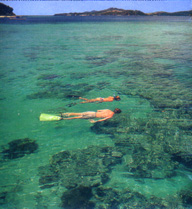 Getting into that island rhythm, for many Turtle Island guests, means enjoying the more placid pastimes such as reading a book, sunbathing on a deserted white sand beach, or swimming in the placid, crystal-clear lagoon. More adventurous visitors can indulge in the diversity of the island's topography — hiking the dense jungle trails, climbing a challenging hill to delight in breathtaking views, exploring the island's natural beauty on horseback or below the sea snorkeling or scuba diving the breathtaking living reefs. An excursion boat spirits Turtle Island guests to one of the neighboring islands to visit the local villages and shell markets. It can be as quiet or busy as you want it.
Getting into that island rhythm, for many Turtle Island guests, means enjoying the more placid pastimes such as reading a book, sunbathing on a deserted white sand beach, or swimming in the placid, crystal-clear lagoon. More adventurous visitors can indulge in the diversity of the island's topography — hiking the dense jungle trails, climbing a challenging hill to delight in breathtaking views, exploring the island's natural beauty on horseback or below the sea snorkeling or scuba diving the breathtaking living reefs. An excursion boat spirits Turtle Island guests to one of the neighboring islands to visit the local villages and shell markets. It can be as quiet or busy as you want it.
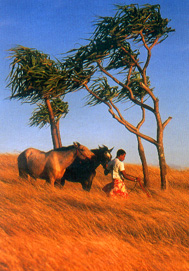 "Turtle is perfect for honeymooners beginning their lives together or for those seeking to celebrate or rekindle a long-standing romance," says Richard Evanson, who insists on being addressed only by his first name. In fact, everyone is on a first-name only basis, especially by the end of the day, when many of the visitors enjoy sitting under the huge Banyan tree, sharing kava (the Fijian ceremonial drink) and song with the staff and other guests. With between 200-250 staff at any given time, your wish is their command. Yet, knowing how to leave guests to their cherished solitude, much of the time you barely see or hear them.
"Turtle is perfect for honeymooners beginning their lives together or for those seeking to celebrate or rekindle a long-standing romance," says Richard Evanson, who insists on being addressed only by his first name. In fact, everyone is on a first-name only basis, especially by the end of the day, when many of the visitors enjoy sitting under the huge Banyan tree, sharing kava (the Fijian ceremonial drink) and song with the staff and other guests. With between 200-250 staff at any given time, your wish is their command. Yet, knowing how to leave guests to their cherished solitude, much of the time you barely see or hear them.
"My island is very special to me," says Richard, "and I want it to be special for my guests... people who truly enjoy the company of others ... relaxing, escaping and becoming good friends." The only difficulty you may encounter on Turtle Island is that of your last day, when you realize after boarding the seaplane, you will leave all of this natural splendor and perfect relaxation behind ... at least until next time, when you return to Turtle Island and the Blue Lagoon. It's an investment in your well-being and one you will not soon forget.
For reservations, contact 877-228-7853 or www.turtlefiji.com

All rights reserved ©
Press Coverage | VentureCapital | Business Development | Venture Opportunities | Resources | Contact Us | Investor Extras | Home